Digital Poster
Major Depressive Disorder
ISMRM & ISMRT Annual Meeting & Exhibition • 10-15 May 2025 • Honolulu, Hawai'i

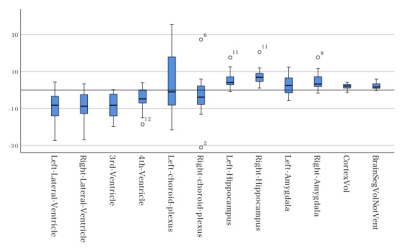 |
Computer Number: 129
2229. Exploring
the Impact of Electroconvulsive Therapy on Glymphatic System
Function in First-Episode Major Depressive Disorder
K. Wada, K. Watanabe, K. Akazawa, E. Chibaatar, N. Okamoto,
P. Quinn, A. Ikenouchi, T. Shinkai, S. Kakeda, R. Yoshimura,
K. Yamada
Kyoto Prefectural University of Medicine, Kyoto, Japan
Impact: This study is the first to demonstrate
glymphatic system improvements from ECT, enhancing our
understanding of its therapeutic mechanisms in major
depressive disorder. These insights could guide more
targeted and effective interventions for treating patients
with major depression disorders.
|
|
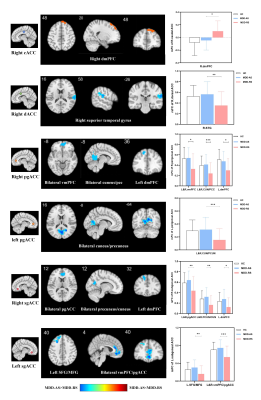 |
Computer Number: 130
2230. State-related
alterations of anterior cingulate cortex subregional
connectivity in major depressive disorder
H. Shao, Z. Zhou, L. Zhang, Y. Gao, H. Li, X. Hu, L. Cao, W.
Bao, M. Tang, Y. Wang, Q. Gong, X. Huang
Functional and Molecular Imaging Key Laboratory of Sichuan Province, West China Hospital, Sichuan University, Chengdu, China
Impact: Our findings highlight the status-related
alterations in rsFC of ACC subregional networks in MDD,
which can help to understand the neurobiological mechanisms
of depression at various stages and provide theoretical
guidance for clinical management.
|
|
 |
Computer Number: 131
2231. A
Cross-Modality Attention Network for Automated Habenula
Segmentation and Quantization by MP2RAGE in Patients With Major
Depression Disorder
B. Bian, Y. Wang, L. Zhang, G. Yang, L. Hou, Y. Jiang, Y.
Song, Y. Meng
First Hospital of Jilin University, changchun, China
Impact: The habenula serves as a pivotal center
modulating intricate behaviors encompassing emotions,
motivation, and decision-making. Automatic and precise
segmentation of habenula provides basis for further
automatic quantitative analysis of habenula for major
depression disorder studies.
|
|
 |
Computer Number: 132
2232. Metabolite
Maps Exhibit Add-on Effects of Creatine Monohydrate on Brain ATP
in Depressed Subjects
Y-H Sung, X-F Shi, P. Renshaw, B. Kious
The University of Utah, Salt Lake City, United States
Impact: Our preliminary findings suggest that add-on
therapy of creatine monohydrate in MDD patients may help
replenish ATP efficiently. Serotonin treatment alone may not
provide enough therapeutic effects in terms of brain
bioenergetics for the buffer system of high-energy
phosphates.
|
|
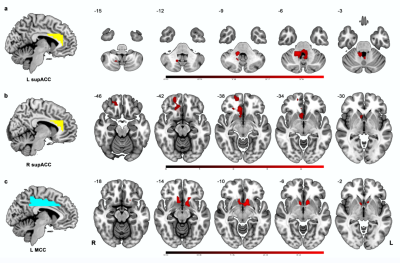 |
Computer Number: 133
2233. Inflammation
is associated with altered functional connectivity of cingulate
cortex in subthreshold depression
z. Qi, P. Chen, W. Cui, Y. Wang
First Affiliated Hospital of Jinan University, GuangZhou, China
Impact: It is suggested that StD may have the tendency
of autoimmune dysfunction. We hypothesize that IL-1β and
IL-17 may show synergistic effects in inflammatory response
and immune regulation, which co-influencing the FC of
ACC-SFG, causing rumination and anxiety.
|
|
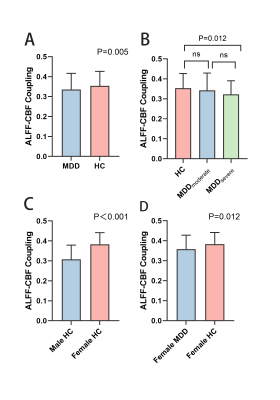 |
Computer Number: 134
2234. Altered
neurovascular coupling in drug-naïve first-episode major
depressive disorder patients
S. Cai, X. Wu, Q. Guo, Y. Fang, Y. Zhang, Y. Lv, H. Yang
The First Affiliated Hospital, College of Medicine, Zhejiang University, hangzhou, China
Impact: Our findings suggest the NVC decoupling may be a
potential pathophysiological mechanism in MDD and provide
insights into understanding its relationships to both
disease severity and gender. In summary, the neurovascular
decoupling may represent a biological marker in MDD.
|
|
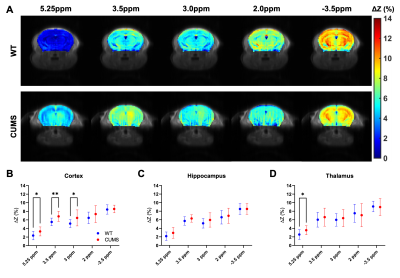 |
Computer Number: 135
2235. CEST
MRI of Regional Molecular Changes in the Brain for Depression
Assessment
J. H. Lai, C. Sun, Y. Liu, S. Qiu, W. Zhang, J. Cai, T. Li
Hong Kong Polytechnic University, Hong Kong, Hong Kong
Impact: The molecular findings here can provide valuable
information for the development of CEST in psychiatry. CEST
is non-invasive and non-contrast-enhanced, which can be
translated to the clinical level for better diagnosis and
treatment planning for depression.
|
|
 |
Computer Number: 136
2236. Subtype
Classification of Major Depressive Disorder Based on Emotional
and Cognitive Brain Networks
X. Zhang, R. Zhao, S. Li, B. Becker, M. Zhang, X. Liu, Q.
Gong, T. Chen
West China Hospital of Sichuan University, Chengdu, China
Impact: The identification of MDD subtypes related to
emotional and cognitive symptoms based on neuroimaging
dimensions may provide valuable evidence for understanding
the heterogeneity of depression and offer insights into
developing personalized treatment strategies.
|
|
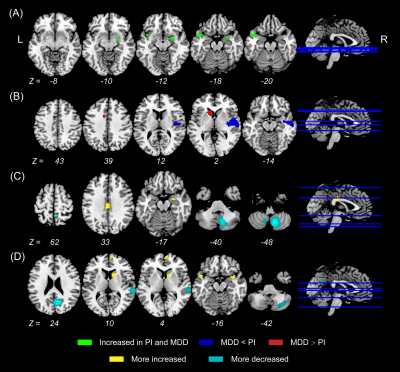 |
Computer Number: 137
2237. Common
and distinct patterns of structural and functional alterations
in gray matter between primary insomnia and major depressive
disorder
W. Du, B. Tang, X. Li, Z. Gao, W. Zhang, S. Lui
West China Hospital of Sichuan University, Chengdu, China
Impact: Our findings advances understanding of the brain
alterations that lead to common and distinct behavioral
manifestations of PI and MDD. Overlapping alterations in
brain activity may indicate potential transdiagnostic
phenotypes, while distinct alterations may provide robust
biomarkers differential diagnoses.
|
|
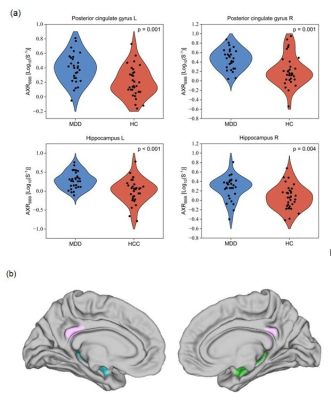 |
Computer Number: 138
2238. Investigating
the Association Between Water Exchange Across the Blood–Brain
Barrier and Depressive Symptoms in Major Depressive Disorder
Y. Ge, L. Chen, Y. Shen, Z. Li, Y. Zhang, D. Shi, Y. Bai, W.
Wei, X. Zhang, K. Li, R. Bai, M. Wang
Zhengzhou University People's Hospital & Henan Provincial People's Hospital, Zhengzhou, China
Impact: This research advances our understanding of the
relationship between blood-brain barrier permeability and
major depressive disorder, potentially providing new
insights into depression's biological mechanisms and
identifying novel therapeutic markers.
|
|
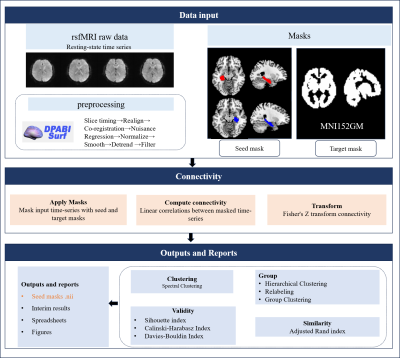 |
Computer Number: 139
2239. Disorganized
functional architecture of hippocampal subregional networks in
major depressive disorder
M. Tang, L. Cao, Z. Zhou, L. Zhang, X. Hu, Y. Gao, W. Bao,
H. Li, Y. Wang, Q. Gong, X. Huang
Department of Radiology and Huaxi MR Research Center (HMRRC), Functional and Molecular Imaging Key Laboratory of Sichuan Province, West China Hospital, Sichuan University, Chengdu, China., Chengdu, China
Impact: Our results of connectivity architectures of
hippocampal subregions demonstrate the functional
segregation of the hippocampus along its long axis and
provide insights into the functional connectivity
alterations within hippocampal subregions associated with
MDD.
|
|
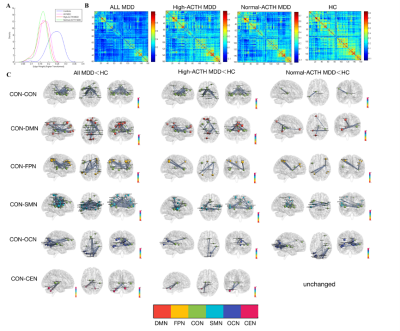 |
Computer Number: 140
2240. Neuroendocrine
Mechanisms in Major Depressive Disorder: A Resting-State fMRI
Study on ACTH-Related Brain Network Changes
S. Tian, C. Yang, W. Du, Y. Miao
the First Affiliated Hospital of Dalian Medical University, Dalian, China
Impact: These findings suggest that MDD patients with
varying ACTH levels exhibit unique brain network
alterations, potentially informing neurobiological
mechanisms and treatment strategies for hormone-related
depression.
|
|
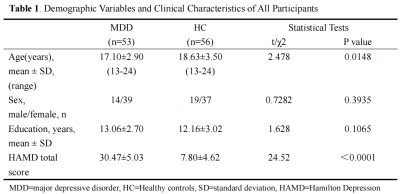 |
Computer Number: 141
2241. A
preliminary study of MRI-visible Perivascular Space indices in
adolescent with major depressive disorder
Y. Yin, X. Lyu, C. Hao, H. Feng, M. Huang, B. Gao
Affiliated Hospital of Guizhou Medical University, Guiyang, China
Impact: These results will provide a new perspective for
the study of the altered neuropathological mechanism of
brain PVS in adolescents with depression
|
|
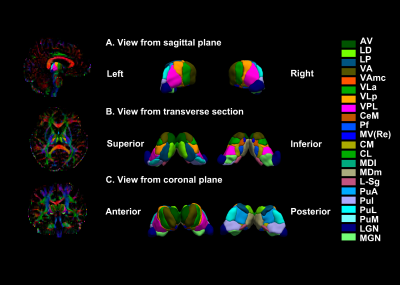 |
Computer Number: 142
2242. Divergent
effects of sex on structural covariance networks of thalamic
nuclei in drug-naive patients with major depressive disorder
Y. Wang, X. Hu, L. Zhang, H. Li, Y. Gao, M. Tang, W. Bao, Z.
Zhou, Q. Gong, X. Huang
Department of Radiology and Huaxi MR Research Center (HMRRC), Functional and Molecular Imaging Key Laboratory of Sichuan Province, West China Hospital, Sichuan University, Chengdu, China
Impact: The study highlights thalamic nuclei changes in
MDD, revealing intrinsic thalamic nodal network alterations
in females. Structural covariation pattern between thalamic
nuclei may be an important marker of sex severity in MDD.
|
|
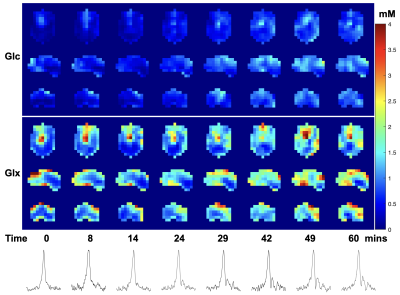 |
Computer Number: 143
2243. Whole-brain
deuterium metabolic imaging (DMI) at 7T for depression
assessment: A preliminary study in healthy volunteers
J. Liu, M. Lafontaine, A. Autry, S. Vaziri, A. Vu, A.
Krystal, T. Ho, Y. Li
University of California San Francisco, San Francisco, United States
Impact: Preliminary results demonstrated the workflow of
employing DMI at 7T to analyze patients with depressive
disorders.
|
|
|
Computer Number:
2244. WITHDRAWN |
The International Society for Magnetic Resonance in Medicine is accredited by the Accreditation Council for Continuing Medical Education to provide continuing medical education for physicians.